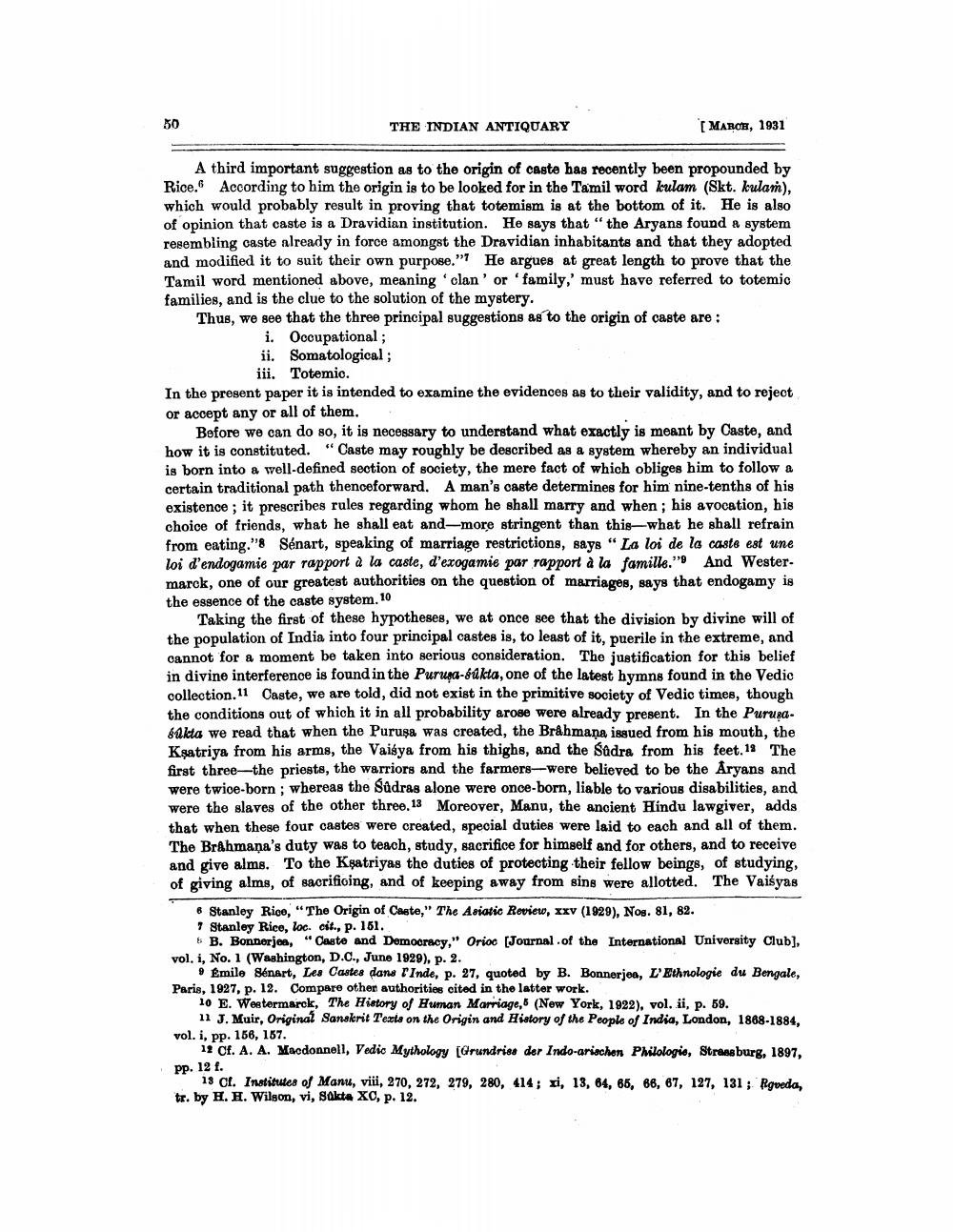________________
50
THE INDIAN ANTIQUARY
[ MARCE, 1931
A third important suggestion as to the origin of caste has recently been propounded by Rice. According to him the origin is to be looked for in the Tamil word kulam (Skt. kulan), which would probably result in proving that totemism is at the bottom of it. He is also of opinion that caste is a Dravidian institution. He says that "the Aryans found a system resembling caste already in force amongst the Dravidian inhabitants and that they adopted and modified it to suit their own purpose." He argues at great length to prove that the Tamil word mentioned above, meaning 'clan' or 'family,' must have referred to totemic families, and is the clue to the solution of the mystery. Thus, we see that the three principal suggestions as to the origin of caste are :
i. Occupational ; ii. Somatological;
iii. Totemic. In the present paper it is intended to examine the evidences as to their validity, and to reject or accept any or all of them
Before we can do so, it is necessary to understand what exactly is meant by Caste, and how it is constituted. "Caste may roughly be described as a system whereby an individual is born into a well-defined section of society, the mere fact of which obliges him to follow a certain traditional path thenceforward. A man's caste determines for him nine-tenths of his existence; it prescribes rules regarding whom he shall marry and when; his avocation, his choice of friends, what he shall eat and-more stringent than this-what he shall refrain from eating."8 Sénart, speaking of marriage restrictions, says " La loi de la caste est une loi d'endogamie par rapport a la caste, d'exogamie par rapport à la famille." And Westermarck, one of our greatest authorities on the question of marriages, says that endogamy is the essence of the caste system. 10
Taking the first of these hypotheses, we at once see that the division by divine will of the population of India into four principal castes is, to least of it, puerile in the extreme, and cannot for a moment be taken into serious consideration. The justification for this belief in divine interference is found in the Purupa-sukta, one of the latest hymns found in the Vedio collection. 11 Caste, we are told, did not exist in the primitive society of Vedic times, though the conditions out of which it in all probability arose were already present. In the Purugadakta we read that when the Puruşa was created, the Brahmana ingued from his mouth, the Kşatriya from his arms, the Vaisya from his thighs, and the Sodra from his feet. 13 The first three-the priests, the warriors and the farmers--were believed to be the Aryans and were twice-born ; whereas the Südras alone were once-born, liable to various disabilities, and were the slaves of the other three. 13 Moreover, Manu, the ancient Hindu lawgiver, adds that when these four castes were created, special duties were laid to each and all of them. The Brahmana's duty was to teach, study, sacrifice for himself and for others, and to receive and give alms. To the Ksatriyas the duties of protecting their fellow beings, of studying, of giving alms, of sacrifioing, and of keeping away from sins were allotted. The Vaisyas
6 Stanley Rice, "The Origin of Caste," The Asiatic Review, xxv (1929), Nos. 81, 82. 7 Stanley Rice, loc. cit., p. 161.
B. Bonnerjea, "Caste and Democracy," Orioc (Journal of the International University Club), vol. i, No. 1 (Washington, D.C., June 1929), p. 2.
Émile Sénart, Les Castes dans l'Inde, p. 27, quoted by B. Bonnerjea, L'Ethnologie du Bengale, Paris, 1927, p. 12. Compare other authorities cited in the latter work.
10 E. Westermarck, The History of Human Marriage, (New York, 1922), vol. ii, p. 59.
11 J. Muir, Original Sanskrit Texts on the Origin and History of the People of India, London, 1868-1884, vol. I, pp. 156, 157.
12 Cf. A. A. Macdonnell, Vedic Mythology (Grundriss der Indo-arischen Philologie, Strassburg, 1897, Pp. 12 f.
18 of. Institutes of Manu, viii, 270, 272, 279, 280, 414; ri, 13, 64, 65, 66, 67, 127, 131; Rgveda, tr. by H. H. Wilson, vi, Sakta Xo, p. 12.




